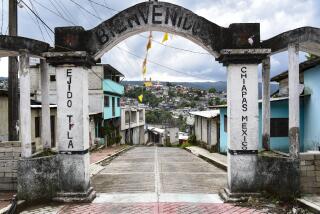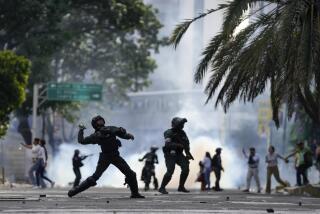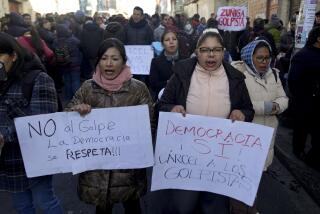Peasant Power in Bolivia
- Share via
SORATA, Bolivia — The police won’t return to this village in the Andes unless the peasants promise not to throw rocks at them.
The peasants rose up and chased the police out months ago, along with the local representative of the provincial government, the judges and even the army. The authorities fled Sept. 20 in the face of a crowd of Aymara Indians armed with little more than sticks and stones, enraged by an insult uttered by an army general hours earlier, and moved by centuries of pent-up frustration.
Since the uprising, this corner of Bolivia -- where the dry Altiplano, a high plateau, around Lake Titicaca meets lush tropical mountains -- has become a kind of an Indian liberated zone.
“Before, they were the bosses. They made us work, they would run everything,” said Felix Puna Mamani, a resident of the neighboring village of Viacha, referring to the people of European descent who have dominated Bolivian society since the 16th century Spanish conquest. “But people realize what’s going on now. It’s not like it was before.”
As many as 1.5 million people -- almost a fifth of Bolivia’s population -- live in areas where indigenous authorities have replaced at least some government functions, said Alvaro Garcia Linera, a university professor in La Paz who has studied the popular movements of Bolivia’s two main indigenous groups, the Aymara and the Quechua.
“Since 2000, we have seen an enormous, continual uprising of indigenous people, with a strong element of Indian nationalism,” Garcia Linera said. “In many places, the institutions of the Republic of Bolivia have begun to fade away.”
Bolivia’s new president, Carlos Mesa, is attempting to lead a sharply divided country and a democracy teetering on the brink of collapse a generation after the last in a series of military dictators stepped down. His government has shown little inclination to confront the peasants.
Guido Arandia, the chief of police for La Paz department, says his officers won’t go back to Sorata and the other towns in rebellion unless they are welcomed.
“It’s not that we don’t want to return,” Arandia said. “But as long as there are no guarantees from the community and its leaders, we cannot place our people at risk.”
In Sorata as in other towns of the region, the locally elected mayor and City Council remain in office -- most of them are Aymara speakers and appear to have the support of the town’s non-Indian minority. But Sorata’s connection to the federal and provincial governments in La Paz remains tenuous at best. The City Council recently considered a hunger strike to force provincial authorities to free up education funds.
With the police gone, “peasant union police” are the only forces of order. They wear the tasseled chicote staff that is an ancient Aymara symbol of village authority.
The Aymara are redistributing land in communal assemblies called Open Councils that issue edicts in the mode of government pronouncements. At some public schools, the rainbow-colored Indian wipata flag flies in place of the Bolivian flag.
People in villages such as Sorata feel that Bolivia’s highly centralized government has failed them. Even before the uprising, the long, slow decline of that government -- which seems more cash-strapped and corrupt with each passing year -- had led the Aymara to rely more on their own, pre-Columbian forms of communal rule.
For Sorata City Council President Eulogio Soto, government neglect is just another example of “that racial discrimination and social injustice which has always been practiced against the Aymara.”
Last year, the federal government failed to disburse half of the $500,000 in public funds promised to Sorata in the annual federal budget, Soto said.
For decades, council members have been asking the government to pave the muddy, winding, avalanche-prone road that is the mountain town’s only link to the outside world. The single government bulldozer assigned to the route is so overmatched by the constant mudslides that groups of children have taken to working on the road themselves, hoping that passing drivers will give them a few coins in thanks.
In the face of the central government’s broken promises, City Council members and Indian leaders in Sorata and elsewhere routinely organize “methods of pressure,” such as blocking roads. Since 2000, such tactics have become commonplace throughout a wide swath of South America, from Lima, Peru, to the northern Argentine provinces of Jujuy and Salta.
Indigenous Movements
In the Aymara villages of the Altiplano, the most vocal leader of the rebellion is Felipe Quispe, a heavyset former professor and president of the peasants union. Known to the Aymara as “el Malku,” or the Condor, he has promised to set off a guerrilla war if his demands on behalf of Bolivia’s indigenous people are not met.
True to his word, four years ago Quispe mustered 20,000 to 40,000 peasants in nearby Rojorojoni to form a “military headquarters.” Quispe’s peasant army was equipped with sticks and rifles from the 1932-35 Chaco War against Paraguay, but fought no engagements. Eventually, all his “troops” went home to their villages. But they have organized more protests since then, repeatedly cutting off the Altiplano’s highways.
Quispe is something never before seen in Bolivia’s racially divided society: an Aymara nationalist with a mass following who advocates the creation of an “Aymara Republic.” The Aymara, Quechua and other indigenous groups make up about 70% of Bolivia’s 8.5 million people.
Another Aymara leader, Evo Morales of the Movement to Socialism party, has a large following among the mostly Quechua coca farmers of east-central Bolivia. He finished second to Gonzalo Sanchez de Lozada in the June 2002 presidential election.
In September, Quispe and Morales announced a nationwide campaign of protests and roadblocks to halt a plan to export Bolivia’s natural gas reserves, which they saw as a sellout to multinational interests.
Those protests, and the events they triggered in Sorata and neighboring towns, would eventually bring down Sanchez de Lozada’s government.
Sorata’s annual religious festival, attended by hundreds of tourists, was just concluding. The new roadblocks, however, left the tourists stranded. Defense Minister Carlos Sanchez Berzain arrived to rescue them.
When word spread that a Cabinet minister had arrived, many people came down from the hills surrounding the town. Few people here could remember when such a high-ranking minister had come to Sorata. Community leaders were eager to tell Sanchez Berzain everything Sorata needed from its government.
Councilman Marco Antonio Giranda wanted to bring up an irrigation project. Councilwoman Cristina Quisber wanted to talk about a long-running request to build a road just over the mountain to farmland that lies fallow because it’s too far to reach on foot.
But the minister said he wasn’t interested. According to several accounts, he was rude and arrogant. “I didn’t come here to talk to anyone,” he reportedly said. “I’m here for the tourists.”
An elderly woman known as Pacha stepped forward to confront Sanchez Berzain, according to several witnesses. “And what are we?” she shouted. “Are we just animals?”
Some residents say one man threw a punch at the minister, though Sanchez Berzain later denied it. A few say he used the word indios, a slur for indigenous people. All agree that his bodyguard fired a machine-gun burst into the air to disperse the crowd.
Soon afterward, the army retreated with the tourists in a caravan of buses. The police had already left in secret the day before, scared off by the angry crowds gathering in the town.
Residents built barricades to block the tourist-army caravan as it tried to wend its way out of Sorata’s narrow valley. In an exchange of gunfire outside town, a local man was killed.
In Sorata, news of the death set off a frenzy of rioting and looting. Residents and peasants from surrounding villages sacked the local court offices and the empty police station.
“The police made the campesinos [peasants] cry,” said Pablo Choqui, a 40-year-old resident of a nearby village. “Our leaders told us to come down to the town, that we needed to help. So we came.”
Four prisoners were freed from the police station’s flea-infested cells. The released men lingered around the town plaza, afraid to run away lest the police return and increase their sentences.
Weeks later, they were still sleeping there -- waiting to see what would happen next.
Expropriating Land
Luis Bocangel was at work at his La Paz restaurant when he got the letter from Sorata delivered by a representative of the peasants union.
Typed out on official union stationery, the letter read much like a government proclamation, despite a few spelling errors. “The honorable Open Council of the Province of Larecaja, meeting in the city of Sorata on Sept. 21,” had officially declared Bocangel “a despot.”
Signed by half a dozen peasant leaders, the letter offered an “ultimatum” to Bocangel, who owned about 170 acres outside Sorata. “Present yourself within 24 hours before the provincial and sectional leaders [of the peasant union] or your land will be completely and definitively expropriated.”
Bocangel traveled to Sorata, met with the Open Council and reached a deal. He would keep the 25 acres where he had built a home and planted a stand of eucalyptus trees. He agreed to hand over the other 145 acres to local peasants.
“I didn’t want any problems, so I went along with them,” he said. “There is no rule of law in Bolivia anymore. What else could I do?”
Aymara leaders in Sorata believe they had every moral right to force Bocangel and half a dozen other absentee landowners to give up their property. The landowners were not complying with their “community obligations,” as defined by centuries-old Aymara customs.
“Every member of the community has to present himself at our civic acts,” said Gregorio Huanca, an Aymara leader from Sorata. “They have to meet with their peasant brothers and share.”
In Aymara culture, all adult men are expected to hold at least one of several rotating community offices. One man in a village is responsible for keeping the cattle from trampling on the crops, for example. Another functions as a town crier.
“These people never show up to anything,” Huanca continued. “They only come once a year to say, ‘This land is mine, don’t touch it.’ ”
While the Open Council was busy expropriating land, the local courts were being looted.
“The court clerks wanted a bribe for anything,” said Roberto Garcia Ortuno, in charge of the civil registry, which is housed in the same building as the courts. “The people were tired of being abused.”
Garcia Ortuno pleaded successfully with the mob not to destroy the civil registry. But all of the criminal and civil court files were tossed from windows and made into a bonfire. Months later, records of property disputes and other civil cases were still drifting across the plaza.
A Wider Uprising
On the same day Sorata’s courts were looted, nine people were killed down the road in Warisata in battles between peasants and the army. News of the bloodshed spread through the Altiplano, causing thousands of peasants to join what soon became a regional uprising.
In nearby Achacachi, most of the town’s able young men began to march toward La Paz, a day’s walk away.
“We sent many, many fighters to La Paz,” Ramon Yujoa, director of the Las Americas school in Achacachi, said proudly.
“They took whatever weapons they could find,” he added, including relics from Bolivia’s last revolution, in 1952.
When the Achacachi residents reached the outskirts of the capital and the sprawling, suburban township called El Alto, they discovered that the indigenous people there had joined the uprising too.
With La Paz surrounded and all its road and air links to the outside world cut off, President Sanchez de Lozada resigned Oct. 17. He went into exile, as did his defense minister, Sanchez Berzain. Both are living in the United States.
In a bid to cool passions, President Mesa approved a political reform plan Feb. 20 that would allow the appointment of a constituent assembly to rewrite Bolivia’s Constitution to grant some local and regional power to Indian communal assemblies. Although no date has been set, the assembly is expected to convene this year.
For the time being, an uneasy truce holds sway. The Bolivian government has made no effort to forcibly reinstate the police in the villages where they have been chased away.
On Feb. 7, Quispe announced that another peasants’ Open Council had held court in Chuma, north of Sorata. They voted to expel the police, the provincial representative and the mayor, he said.
The villagers raised the wipata flag over the empty police station.
In Sorata, meanwhile, the City Council has tried to persuade provincial authorities to bring the police back. They fear that the lack of officers is scaring away the tourist trade.
“The police told us they wanted a written guarantee that nobody would hurt them, so we gave it to them, even though they are the ones who are supposed to guarantee our safety,” said Soto, the City Council president. But then the police asked for a similar promise from the peasants union and Aymara communal authorities, who have declined.
In the meantime, the prisoners freed in September have disappeared.
“They went to try their luck in the world,” Garcia Ortuno said.
More to Read
Sign up for Essential California
The most important California stories and recommendations in your inbox every morning.
You may occasionally receive promotional content from the Los Angeles Times.











